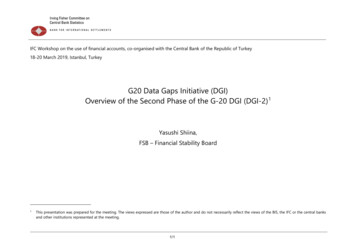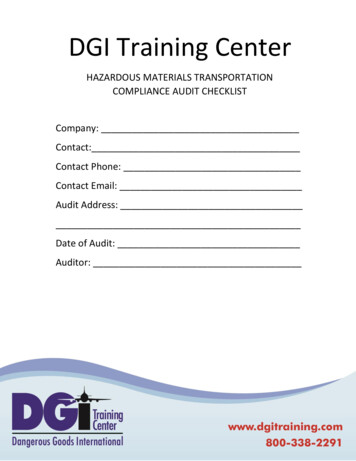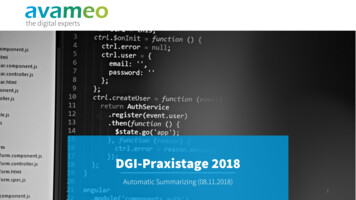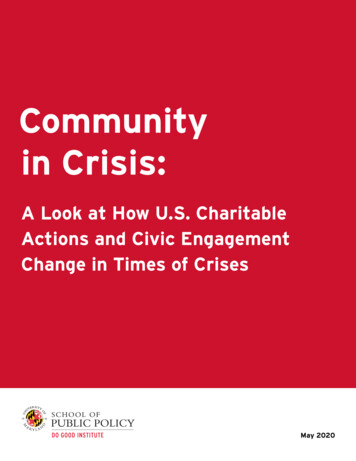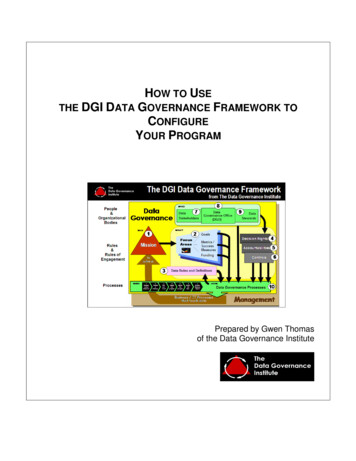
Transcription
HOW TO USETHE DGI DATA GOVERNANCE FRAMEWORK TOCONFIGUREYOUR PROGRAMPrepared by Gwen Thomasof the Data Governance Institute
How to Use the DGI Data Governance Framework to Configure Your ProgramContentsWhy Data Governance? . 3Why the DGI Data Governance Framework Was Created. 4How the Framework is Organized . 5Using the Framework to Configure Your Program . 7Getting Started . 7Components 1-6: Rules and Rules of Engagement. 91. Data Governance Missions and Visions. 92. Goals, Governance Metrics and Success Measures, and Funding Strategies . 93. Data Rules and Definitions. 104. Decision Rights. 125. Accountabilities. 126. Controls. 12Components 7-9: People and Organizational Bodies . 137. Data Stakeholders. 138. A Data Governance Office (DGO). 149. Data Stewards. 15Component 10: Processes . 15Summary. 16 2009 the Data Governance Institutewww.DataGovernance.comPage 2
How to Use the DGI Data Governance Framework to Configure Your ProgramWhy Data Governance?If you go back several decades in the world of IT, you’ll find that early systems were typically wellgoverned. Not many people had “hands-on-keyboard” ability to change the architecture of a system or toinput control files; those who were given this ability understood the rules. It was expected that they wouldadhere to standards, naming conventions, change control, and other aspects of governance. DataManagement disciplines included Data Governance activities, even if they weren’t labeled as such.And then everything changed. Now we have an ever-growing list of computing devices, with an everexpanding list of people with “hands-on-keyboard” abilities to add data and to change how data isstructured, stored, and linked. Those whose job titles include the words “Data Management” can nolonger effectively govern data on their own. Governance requires a collaboration between many roles.During the 1990s, this need for joint control took the form of theBusiness/IT Collaboration Model“Business/IT Collaboration Model” – a paradigm that says Businessgroups and IT groups need to collaborate so that the informationneeds of the business can be met. Sometimes this model worked well,especially in small projects where only one business group and onetechnical team were represented. In more complex situations,however, this model often had poor results. Why? Technology teamswere asked to produce information that was fit for use by multiple business stakeholders, but IT insistedthat information requirements were the responsibility of business. No one group served as advocate forthe information needs of the business.A New ParadigmSlowly, the Business/IT Collaboration Model has beensupplemented by other paradigms designed to improvecollaboration while ensuring accountability for meeting informationstakeholders’ needs. One of these is the B-I-T Sequence from theData Governance Institute (DGI).The B-I-T SequenceThe DGI B-I-T Sequence states thatBusiness needs driveInformation needs, which driveTechnology strategies and approaches.In other words, information technology does not exist for its own sake. IT exists to meet the informationneeds of the business. To succeed in this mission, technology teams must understand those informationneeds. They must understand how to prioritize competing requirements and how to resolve conflictswhen they arise. They must understand who has the authority to speak for each stakeholder group duringrequirements setting and conflict resolution. They must understand the policies, standards, and rulesthey’re expected to adhere to as they build, maintain, and enhance systems. 2009 the Data Governance Institutewww.DataGovernance.comPage 3
How to Use the DGI Data Governance Framework to Configure Your ProgramTechnology resources working with data may help enforce these policies,standards, and rules, but they typically only create the most technical ofthem. For all the others, they need definitive input from businessresources.They need Data Governance just as strongly as the business does.One of the purposes of a Data Governance program is to serve asadvocate for the information needs of the business. It helps sort outand align overlapping accountabilities for meeting those needs. Data GovernanceThe “I” in the B-I-T SequenceThe bulk of the work of Data Governance takes place in that area where business and technology concernsoverlap to address information needs. Of course, Data Governance is not the only thing taking place in thisspace. Many other efforts have drivers andconstraints that influence how data,information, records, documents, and otherinformation types are managed and governedin this space.Stakeholders from these efforts may play a rolein Data Governance. Or, they may already beperforming processes and services (such as changecontrol and issue resolution) that can be leveraged bythe Data Governance program. Data Governance, Data Architecture,Change Control, Metadata Management,Master Data Management, Records Management,Document Management, Privacy Protection,Access Management, etc.In this case, Data Governance can help ensure thatthese various stakeholder groups’ needs areacknowledged and considered during data-relatedprojects. Data Governance can help align these stakeholders’ needs and provide checks-and-balancesbetween those who create/collect information, those who consume/analyze it, and all these otherstakeholder groups.Why the DGI Data Governance Framework Was CreatedIn complex organizations, it’s not easy to identify – much less meet – all data stakeholders’ informationneeds. Some of those stakeholders are concerned with operational systems and data. Some are concernedabout analysis, reporting, and decision-making. Some care primarily about data quality, while others arefrustrated by architectural inadequacies that keep users from linking, sorting, or filtering information.Some data stakeholders focus on controlling access to information; others want to increase abilities to 2009 the Data Governance Institutewww.DataGovernance.comPage 4
How to Use the DGI Data Governance Framework to Configure Your Programacquire and share data, content, documents, records, and reports. And still others focus on compliance,risk management, security, and legal issues.Each of these data stakeholder groups may have a different vocabulary to describe their needs, theirdrivers, and their constraints. Typically, they have trouble communicating with each other. Indeed, theymay not even have the same set of requirements in mind when they call for better governance of data.Frameworks help us organize how we think and communicate about complicated or ambiguous concepts.The Data Governance Institute wanted to introduce a practical and actionable framework that could help avariety of data stakeholders from across any organization to come together with clarity of thought andpurpose as they defined their organization’s Data Governance and Stewardship program and its outputs.The framework includes ten components – elements that would typically be present in any type or size ofData Governance effort. They apply to new programs and established ones, fairly informal efforts andrigorous ones, programs that are sponsored by IT staff, and those that are sponsored by the business sideof the organization. These components are present in programs that involve just a handful of participants,and those that involve hundreds or even more participants. They are factors in stand-alone DataGovernance programs, and in efforts where Data Governance is co-managed with Data Quality,Compliance, Data Architecture, or some other set of activities.As you consider your own program, then, you’ll want to consider how these universal components may berepresented in your own unique culture and environment. In this paper, we’ll go through a step-by-stepprocess for using these framework components to configure your own Data Governance and Stewardshipprogram.How the Framework is OrganizedSome of the words used in describing Data Governance – such as “Decision Rights” – may not be familiarto us all. But the framework is organized using the familiar WHO – WHAT – WHEN – WHERE – WHYpattern. In working with the framework, you will be encouraged to clarify: WHY your specific program should exist WHAT it will be accomplishing WHO will be involved in your efforts, along with their specific accountabilities HOW they will be working together to provide value to your organization WHEN they will performing specific processes.Another way to look at your program is to consider The RULES that your program will be creating, collecting, aligning, and formalizing(policies, requirements, standards, accountabilities, controls, data definitions, etc.) and the RULESof ENGAGEMENT that describe how different groups work together to make those rules andenforce them The PEOPLE AND ORGANIZATIONAL BODIES involved in making and enforcing those rules, and 2009 the Data Governance Institutewww.DataGovernance.comPage 5
How to Use the DGI Data Governance Framework to Configure Your Program The PROCESSES that these people follow to govern data, while creating value, managing cost andcomplexity, and ensuring compliance.Both of these schemas are represented the framework graphic, as well as in the list of frameworkcomponents.The DGI Data Governance FrameworkRules and Rules of EngagementPeople and Organizational Bodies1. Mission and Vision2. Goals, Governance Metrics and SuccessMeasures, and Funding Strategies3. Data Rules and Definitions4. Decision Rights5. Accountabilities6. Controls 2009 the Data Governance Institute7. Data Stakeholders8. A Data Governance Office (DGO)9. Data StewardsProcesses10. Proactive, Reactive, and Ongoing DataGovernance Processeswww.DataGovernance.comPage 6
How to Use the DGI Data Governance Framework to Configure Your ProgramUsing the Framework to Configure Your ProgramDesigning your Data Governance and Stewardship program is not necessarily a linear progression. Instead,you’ll make decisions about each of your program components based on decisions about othercomponents. And so, while we’ll present these steps linearly, you’ll actually look at your initial programdesign effort holistically.Getting StartedActually, though, “designing” your program is not the first step you should be looking at. Here are thesteps in a Data Governance program lifecycle.1.2.3.4.5.6.7.Develop a value statementPrepare a roadmapPlan and fundDesign the programDeploy the programGovern the dataMonitor, measure, report.The Data Governance Program LifecycleValue StatementsOrganizational leaders rarely support the move to formal Data Governance “just because” it’s a good idea.Instead, these programs receive support because they can help address specific organizational goals. Justlike any other effort that requires time, resources, and attention, Data Governance efforts shouldultimately help the organization Make money, meet its mission, and/or increase the value of assetsManage costs and/or complexitySupport other necessary efforts, such as Security, Compliance, or PrivacyAs you consider your program, be sure that you’re clear about which of these concerns you’re addressing.Be prepared to track each of your program’s specific efforts to at least one of these categories.What will those specific efforts be? Here’s where Data Governance programs differ so greatly that we saythere are different “flavors” of Data Governance. Some exist specifically to support Data Quality efforts,and most of their program activities involve measuring, monitoring, and improving information quality.Data Governance facilitators may spend much of their time translating requirements between businessand technical staff and in reporting quality metrics to management and other data stakeholders. DataGovernance may consist of a series of “routine” activities containing both business and IT-run tasks. 2009 the Data Governance Institutewww.DataGovernance.comPage 7
How to Use the DGI Data Governance Framework to Configure Your ProgramOther Data Governance programs exist because their organizations find it difficult to connect sets ofinformation in a way that support Business Intelligence, mergers and acquisitions activities, or gaining newcapabilities. For these organizations, Data Governance activities may focus on bringing cross-functionalgroups together to make complicated decisions about their data environments, how to use information,or how to prioritize data-related projects. For these organizations, Data Governance leaders may spendmuch of their time “bringing pieces of the puzzle together”: identifying data stakeholders and theirinformation needs, ensuring that research and analysis takes place, facilitating decision-making sessions,and then following up on projects and processes that come out of those decisions. Here, Data Governancemay be very political in nature.Still other organizations may understand their business needs and their data environments and the level ofinformation quality they require to meet their goals. For these groups, the challenge is to keep individualsand teams from making “mistakes.” This flavor of Data Governance program may be primarily concernedwith authority and controls. Activities may focus on policy enforcement, access control, setting standardsfor metadata and master data, or ensuring that new data elements don’t introduce duplicate fields. Atthese organizations, Data Governance participants may seem like “data cops.”Which of these flavors of Data Governance seems most like what you need? What DO you need?Specifically, what activities do you think will need to take place as part of your Data Governance efforts?Be prepared with concise value statements that describe what you want to do, and what will be the resultsof those actions, and what will be the ultimate impact.Consider using an A, B, C approach: If we do A, then we can expect B, which should lead to C. If we improve our data quality in the Customer repository, then our marketing reports will havemore accurate information, which should lead to more confident business decisions.If our Data Stewardship Committee addresses this data integration problem, then we’ll have theopportunity to hear from multiple stakeholders with different perspectives, which reduces thechance that we’ll break something else when we fix this.If our Data Governance team reviews new Product master data, then we’ll catch any non-standarddata before it can cause a problem, and we’ll avoid the cost of re-work.The Rest of the Data Governance LifecycleAfter you develop value statements for your activities, you’ll want to create a high-level roadmap thattakes into account known drivers and constraints for those activities. Then you’ll want to develop a highlevel plan that you can use to socialize your ideas and to obtain funding commitments. Only after you hearfrom major stakeholders about their support for the program’s value and their willingness to contributeresources will you be ready to complete your formal program design using the components of the DGIData Governance Framework.Of course, this doesn’t mean you can’t get a head start by making some preliminary configuration choices.You’ll actually need to do this, so you can have details to discuss with major stakeholders as you discussyour anticipated mission and value statements. But most programs discover that stakeholder input at this 2009 the Data Governance Institutewww.DataGovernance.comPage 8
How to Use the DGI Data Governance Framework to Configure Your Programpoint leads to adjustments to those preliminary choices. So while you’re painting a picture to stakeholdersabout what life will be like after you’ve deployed a program and are actively governing your data, be sureto listen to their expectations.Also, remember that every time you make a major change in program scope or direction, you should runthrough the entire Data Governance program lifecycle again, so you can be sure of achieving clarity ofpurpose and stakeholder buy-in for the new activities.Components 1-6: Rules and Rules of Engagement1. Data Governance Missions and VisionsIn some organizational cultures, it’s important to develop formal mission statements and visionstatements. Other places don’t always create these documents. Regardless of your culture, you shoulddevelop a clear statement of what will be different and better if you have formal Data Governance. Usethis with your value statements to paint clear before-and-after pictures for your data stakeholders.Remember to revisit this component every time you address a new set of data, a new repository, a newset of processes, or a new set of stakeholders. Always be prepared to deliver clear, concise, A-B-Cstatements about what you’re doing, and why.Also, remember that your program may have multiple missions and focus areas. That’s ok. Each one will beimplemented in phases, but not necessarily in lockstep.2. Goals, Governance Metrics and Success Measures, and Funding StrategiesSome organizations make the mistake of onlyTypical universal goals of a Data GovernanceProgram:publicizing high-level program goals. Consider thesegoals from the Data Governance Institute website at1. Enable better decision-makingwww.datagovernance.com. They’re good and2. Reduce operational frictionimportant goals, but you’ll want to supplement them3. Protect the needs of data stakeholders4. Train management and staff to adoptwith specific, actionable statements that describe yourcommon approaches to data issuesprogram scope, the results you’re looking for (from5. Build standard, repeatable processes6. Reduce costs and increase effectivenessyour A-B-C value statements), and how you’ll measurethrough coordination of effortsyour progress. Consider7. Ensure transparency of processes What data subject areas will you address? What specific repositories? What’s “wrong” with them now that you’ll address? What will they look like with Data Governance and Stewardship? What data management processes and practices will be affected, and how? What related business or technology processes and practices will be affected, and how? How will people work together in ways that they’re not now, and what will be the result? 2009 the Data Governance Institutewww.DataGovernance.comPage 9
How to Use the DGI Data Governance Framework to Configure Your Program How will this affect how data-related decisions are made? Whether data is trusted? The quality ofbusiness decisions?How will personal accountability be affected by Data Governance and Stewardship?Will any groups’ pain points be addressed? How?What affect will better standards and more transparency have on your audit and complianceactivities?Funding Data Governance and Stewardship programs can be tricky, because they involve multiple types ofefforts: A project to fund the design and kick-off of your program. Funding for ongoing program administration, stakeholder care, and preparation for meetings anddecisions. Funding for Data Stewards and support functions to examine issues, define data, establish rules,specify controls, and recommend projects to address data-related issues. Funding for projects to respond to those recommendations.Some organizations have stand-alone Data Governance budgets to address all these efforts. Others takeadvantage of other groups’ budgets. Still others are forced to fit all efforts – even ongoing program tasks –into project budgets.Whichever fits your funding model, consider whether you will need to acquire project codes for DataStewards and other participants with ongoing responsibilities, or for data management, metadatamanagement, and technology resources asked to participate in research and analysis.Also consider how you will approach unplanned efforts to respond to stakeholders’ requests to analyzeissues and make recommendations. You want to avoid becoming a “black hole” into which requests fall,with no way to deliver value.3. Data Rules and DefinitionsUltimately, Data Governance is about rules: collecting, creating, defining, aligning, prioritizing, monitoringand enforcing many types of data-related rules. These may take the form of: PoliciesStandardsGuidelinesRequirementsGuiding PrinciplesBusiness Rules Data Quality RulesData Usage RulesData Access Rules“Golden Copy” designations“System of Record” designationsetc.Your Data Governance team might not be the ones to do the work of collecting, creating, defining,aligning, prioritizing, monitoring and enforcing these rules. But you should understand who will. Youshould also have input into who will make decisions about them, using what decision rights models. Often, 2009 the Data Governance Institutewww.DataGovernance.comPage 10
How to Use the DGI Data Governance Framework to Configure Your ProgramData Governance programs discover that certain data stakeholders (often those who need to analyze dataor those who need to collect proof of compliance with regulations and laws) are not adequatelyrepresented in rule-related processes. Data Governance can serve as advocates for these stakeholders,insisting on appropriate representation.Your approach to rules will help determine what your organization will look like. If you concentrate on onlya few types of rules in a few locations, you may not need a large organization. If you have a few rules thatmust be applied many places, you may need to assign stewardship responsibilities to many roles. If youwant to work with many rules in many contexts, you may decide to build a hierarchical Data Governanceand Stewardship organization with some groups focusing on high-level issues and others focused ondetails.A special category of rules are agreed-upon data definitions and other metadata. Many new DataGovernance programs focus on documenting these, since they are foundational to other Data Governanceactivities. Other programs leave this work to Data Architects, Metadata Specialists, or others.As you configure your own Data Governance and Stewardship program, you should consider the following:Current State How does your organization deal with policies, standards, and other types of rules? Who can create them? Where are they stored? How are they disseminated? Do managers enforce them? How do business and technical staff respond to them? What other groups work with data-related rules? What type of alignment is missing between these groups?Future Vision What type of alignment should you aim for with these groups? What are your organization’s pain points, and how might Data Governance address them? What types of rules would need to be in formalized to do this? What data subject areas should the rules be initially applied to? What about later? What areas of the data environment would initially be affected? What about later? What compliance rules will need to be considered? Will it be more effective to introduce a group of rules all at once, or a few at a time? Who needs to approve rules that come from the Data Governance program? Who should beconsulted before they are finalized? Who should be informed before they are announced?You will not work with this component of the DGI Data Governance Framework in isolation. Instead,consider that rules are both inputs to and outputs of Data Governance processes. Working with ruleseffectively will require the involvement of most framework components. 2009 the Data Governance Institutewww.DataGovernance.comPage 11
How to Use the DGI Data Governance Framework to Configure Your Program4. Decision RightsData Governance involves making a lot of decisions. Your program will need to establish who has the rightto make what types of decisions, and when, following what types of protocols. Likewise, you’ll want toconsider your ongoing processes and practices that affect how data is structured, organized, defined,made available or restricted, disseminated, and even created/collected. What types of decisions are madeon an ongoing basis? Who should make them, and who should be consulted or informed?Some organizations document decision rights in great detail. Others reach agreements on these rights, butdon’t document them. You should understand your culture’s approach to establishing decision rights, andhow well that approach has been working. Then decide whether you want to introduce new levels offormality in this area as part of your Data Governance program.Regardless, consider this technique: Whenever program participants are called together to make adecision, pause. Before making the decision, re-iterated your decision-making approach, and ask forvalidation. This simple step can go a long way toward making “decisions that stick.”5. AccountabilitiesObviously, you’ll need to assign clear and achievable accountabilities for work within your DataGovernance and Stewardship program. You’ll want to define roles and responsibilities for programparticipants. But that’s not where the accountabilities component ends.Often, organizations’ issues with their data can be traced to unclear accountabilities somewhere along adata flow. Your program’s analysis will uncover these gaps. Often, it is the responsibility of a DataGovernance program to suggest or validate appropriate responsibilities for data management, metadatamanagement, and other information-related activities. Any time your program participants suggest a newprocess, practice, or control, consider your options for assigning accountabilities.Consider using the B-I-T Sequence to articulate high-level beliefs about who should do what, and when,and why. Once you have consensus, then you can translate those agreements into more detailedaccountability charts and tools.6. ControlsAll data is at risk: at risk of being inappropriately used or displayed, at risk of being corrupted, at risk ofbeing inaccurate or incomplete. Data also represents risk: the consequences should any of these thingsoccur.How do we deal with risk? We manage it, preferably by preventing the events that we don't want to occur.Those we can't be sure of preventing, we at least detect, so we can then correct the problem.How are risk management strategies made operational? Through controls – those things we put in place tokeep something from happening (preventative controls, such as firewalls to keep out intruders) or controlsto discover if something did happen and to do something about it (detective/corrective controls, such asvirus scans.) 2009 the Data Governance Institutewww.DataGovernance.comPage 12
How to Use the DGI Data Governance Framework to Configure Your ProgramControls can be automated, manual, or technology-enabled manual processes. You may find it useful todescribe some of the work that Data Stewards do in terms of specifying, designing, implementing, orperforming data-related controls.You may also be asked to recommend data-related controls that could be applied to user processes,applications, databases, or other parts of the data environment. Examples are Change Control, sign-offs,and data quality checks embedded into applications.You may be asked to recommend ways that existing general controls (policies, training, processes, projectmanagement steps, etc.) could be modified to support governance goals. You may even be asked to assistwith internal or external audits by explaining how different data-related controls build upon each other.It may not be necessary for all your program’s participants to know how to translate their “good practices”to the language of risk and controls. But your key players should be able to.Components 7-9: People and Organizational BodiesThe term Data Governance is sometimes accused of being a misnomer. After all, are we really governingthe bits and bites that are our data? Most of our effort is really focused on controlling the behavior ofindividuals and groups and systems that touch that data. The next three components of the DGI DataGovernance Framework look at people and organizat
Slowly, the Business/IT Collaboration Model has been supplemented by other paradigms designed to improve collaboration while ensuring accountability for meeting information stakeholders' needs. One of these is the B-I-T Sequence from the Data Governance Institute (DGI). The DGI B-I-T Sequence states that Business needs drive


